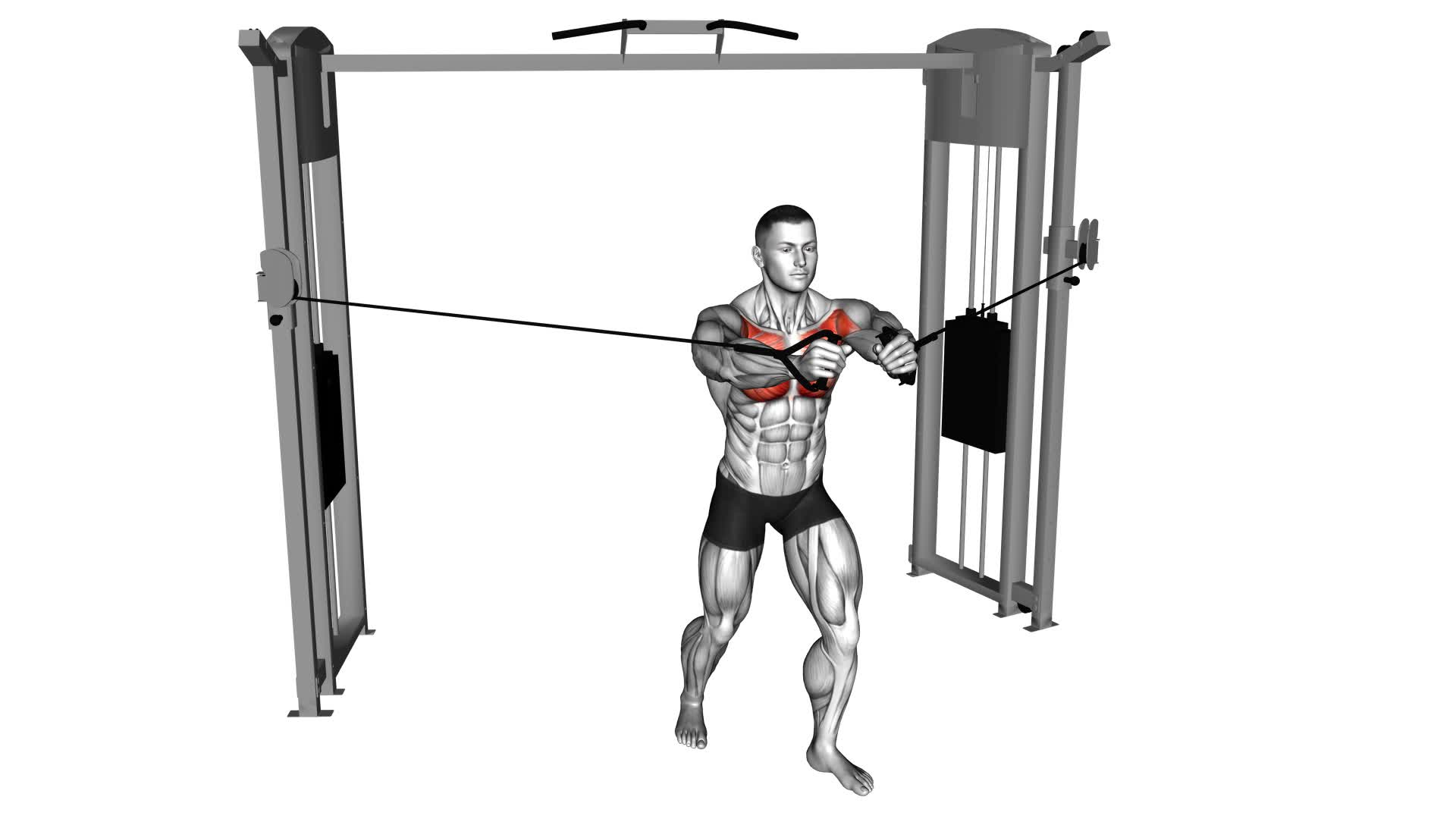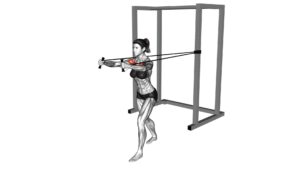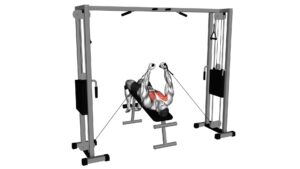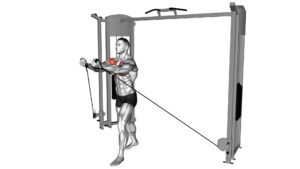Cable Middle Fly – Video Exercise Guide & Tips

Are you looking to strengthen and tone your chest muscles? Look no further than the Cable Middle Fly!
Watch This Exercise Video
This video exercise guide and tips article will provide you with all the information you need to perform this effective exercise correctly.
With the proper form and technique, you can maximize your workout and achieve great results.
Get ready to sculpt your chest muscles and improve your overall upper body strength with the Cable Middle Fly.
Let's get started!
Key Takeaways
- Cable middle fly targets and strengthens the chest muscles, providing significant improvements.
- It offers a greater range of motion compared to dumbbell flyes, maximizing effectiveness and preventing injury.
- Engaging the core muscles for stability is important during cable middle fly exercises.
- There are variations and modifications, such as single-arm cable middle fly or standing cable middle fly, to target different muscle groups and achieve better results.
Benefits of Cable Middle Fly
You will experience significant improvements in your chest muscles through regular practice of the cable middle fly exercise. Cable middle fly variations are a great way to target and strengthen your pectoral muscles.
By using cables, you can add resistance to your workouts, allowing for a more effective and challenging exercise. One of the main benefits of cable exercises is the constant tension it provides throughout the movement. Unlike other exercises that rely on gravity for resistance, cables keep your muscles engaged throughout the entire range of motion, leading to better muscle activation and development.
Additionally, cable middle fly variations allow for a greater range of motion compared to traditional dumbbell flyes. This means that you can fully stretch and contract your chest muscles, promoting better muscle development and flexibility. Incorporating cable exercises like the middle fly into your routine can also help improve your overall strength and stability, as it engages your core muscles to maintain proper form.
Now that you understand the benefits of cable exercises, let's move on to the equipment needed for cable middle fly.
Equipment Needed for Cable Middle Fly
To perform cable middle fly exercises, you'll need essential equipment such as a cable machine with adjustable pulleys and handles. These allow you to adjust the height and resistance for an effective workout.
If you don't have access to a cable machine, you can explore alternative exercises that target the same muscle groups, such as dumbbell flys or resistance band flys.
Essential Cable Fly Equipment
To perform the Cable Middle Fly exercise, it's essential to have the proper equipment. Here are the items you'll need:
- Cable machine: This is the main equipment for performing cable flys. Make sure it's properly set up and adjusted to the appropriate height.
- D-handle attachments: These attachments are used to grip the cables and perform the exercise. Choose ones that are comfortable and easy to grip.
- Weight plates: The cable machine requires weight plates to create resistance. Use plates that are appropriate for your fitness level and goals.
- Bench or stability ball: A bench or stability ball is needed to provide support and stability during the exercise.
Now that you know the essential equipment for cable flys, let's explore some alternatives to this exercise.
Alternatives to Cable Flys
One option to consider as an alternative to cable flys is using resistance bands. Resistance bands are a versatile and portable piece of equipment that can provide similar benefits to cable flys.
To perform a chest workout with resistance bands, you can use them to do exercises like chest presses, chest flies, and push-ups. Chest presses involve pushing the bands forward while keeping your arms straight.
For chest flies, you can wrap the bands around your back and bring your hands together in front of your chest.
Push-ups can be done by placing the bands across your upper back and holding onto the handles, then performing the push-up motion.
These alternative exercises can effectively target your chest muscles and provide a challenging workout.
Proper Form and Technique for Cable Middle Fly
Now that you understand the equipment needed for Cable Middle Fly, it's important to focus on proper form and technique.
Correct technique is crucial to maximize the effectiveness of this exercise and prevent injury. By maintaining proper form, you can target the intended muscles and achieve optimal results from your Cable Middle Fly workout.
Correct Cable Middle Fly Technique
Achieving proper form and technique for the Cable Middle Fly exercise is essential for maximizing its effectiveness and avoiding injury. Here are some key tips to help you perform the exercise correctly:
- Keep your core engaged and maintain good posture throughout the movement.
- Start with light weights and gradually increase as you become comfortable with the exercise.
- Focus on squeezing your shoulder blades together as you bring your arms back.
- Control the movement and avoid using momentum to ensure proper muscle activation.
By following these guidelines, you can reap the benefits of the Cable Middle Fly, such as improved upper body strength and posture.
Additionally, there are variations of this exercise that you can explore to target different muscle groups and add variety to your workout routine.
Importance of Proper Form
To maximize the effectiveness of the Cable Middle Fly exercise and prevent injury, it's crucial that you prioritize proper form and technique. The importance of proper form can't be overstated. By maintaining proper form, you ensure that you're targeting the intended muscles and maximizing the benefits of the exercise. It also helps to prevent strain on other muscles and joints.
One common mistake to avoid is using too much weight. When the weight is too heavy, it can lead to poor form and compromised technique. Another mistake isn't maintaining a stable core. Engaging your core muscles throughout the exercise helps to stabilize your body and maintain proper form.
Variations and Modifications for Cable Middle Fly
To increase the effectiveness of your cable middle fly exercise, regularly incorporate variations and modifications into your routine. Here are some options to keep your workouts challenging and engaging:
- Single-arm cable middle fly: Perform the exercise with one arm at a time to isolate and target each side of your chest.
- Standing cable middle fly: Instead of sitting or kneeling, perform the exercise in a standing position to engage your core and improve overall stability.
- Reverse cable middle fly: Start with your arms crossed in front of your chest and pull the cables outward, targeting the rear deltoids and upper back muscles.
- Cable middle fly with resistance bands: Add resistance bands to the exercise to increase the tension and work your chest muscles from different angles.
By incorporating these variations and modifications into your cable middle fly routine, you can prevent boredom, challenge your muscles in new ways, and achieve better overall results.
Now, let's move on to the next section and discuss some common mistakes to avoid during cable middle fly.
Common Mistakes to Avoid During Cable Middle Fly
To maximize the effectiveness of your cable middle fly exercise and avoid common mistakes, it's important to maintain proper form and technique. By ensuring that you perform the exercise correctly, you can target the intended muscles and reduce the risk of injury.
One common mistake to avoid during the cable middle fly is using too much weight. It's crucial to choose a weight that allows you to maintain control and perform the exercise with proper form. Using excessive weight can lead to incorrect movement patterns and strain on your muscles and joints.
Another mistake to watch out for is improper body positioning. Make sure to stand with your feet shoulder-width apart and maintain a slight bend in your knees. Keep your core engaged and your back straight throughout the exercise. This will help stabilize your body and prevent any unnecessary strain on your lower back.
Additionally, avoid rounding your shoulders or hunching forward during the movement. Keep your shoulders back and down, and focus on squeezing your shoulder blades together as you bring your arms forward. This will engage your chest muscles properly and prevent any undue stress on your shoulders.
Tips for Maximizing Your Cable Middle Fly Workout
For an effective cable middle fly workout, use proper form and technique to target your intended muscles and minimize the risk of injury. Here are some tips to help you maximize your results and avoid common errors:
- Maintain proper posture: Stand tall with your chest up, shoulder blades pulled back, and core engaged. This will help you isolate and engage your middle chest muscles more effectively.
- Control the weight: Avoid using momentum or swinging your body during the exercise. Instead, focus on slow and controlled movements to fully engage your muscles and maximize the benefits of each repetition.
- Adjust the cable height: Depending on your height and preference, adjust the cable height to ensure that your hands are at chest level when fully extended. This will allow for a full range of motion and proper muscle activation.
- Mind your grip: Make sure to maintain a neutral grip throughout the exercise. Avoid gripping the handles too tightly, as it can lead to unnecessary tension in your forearms and wrists.
Frequently Asked Questions
How Many Sets and Reps Should I Do for Cable Middle Fly?
To determine the number of sets and reps for cable middle fly, it's important to consider your fitness goals and current fitness level. The number of sets and reps can vary depending on your specific needs and preferences.
It's recommended to consult with a fitness professional or personal trainer who can provide guidance tailored to your individual needs.
Additionally, there are various variations of cable middle fly that you can incorporate into your workout routine to target different muscle groups.
Can I Do Cable Middle Fly if I Have Shoulder or Back Injuries?
If you have shoulder or back injuries, it's important to exercise caution when performing the cable middle fly. Consult with a healthcare professional or a certified trainer who can provide you with modifications specific to your shoulder injury.
If cable middle fly isn't recommended for your back injury, there are alternative exercises that can target the same muscles, such as dumbbell fly or push-ups.
Always prioritize your safety and listen to your body.
How Often Should I Incorporate Cable Middle Fly Into My Workout Routine?
Should you incorporate cable middle fly into your workout routine and how often?
Cable middle fly is a beneficial exercise that targets your chest muscles. It helps to strengthen and tone your pectoral muscles, improving upper body strength and posture.
To incorporate it into your routine, aim to perform cable middle fly 2-3 times per week, allowing at least one day of rest in between. Be sure to start with a weight that's challenging but manageable, and gradually increase as you get stronger.
Is It Better to Use a Higher or Lower Cable Pulley for Cable Middle Fly?
When performing cable middle fly, you might wonder whether it's better to use a higher or lower pulley. The choice depends on your specific fitness goals and the muscle groups you want to target.
Using a higher pulley can emphasize your upper chest and shoulders, while a lower pulley will engage your lower chest and triceps.
Experiment with both positions to find what works best for you and helps you achieve the desired results.
Can I Perform the Cable Middle Fly Exercise With Resistance Bands Instead of a Cable Machine?
Yes, you can perform the cable middle fly exercise with resistance bands instead of a cable machine.
Using resistance bands for the cable middle fly provides similar benefits as using a cable machine, such as targeting your chest muscles and improving upper body strength.
Resistance band exercises offer the advantage of being portable and versatile, allowing you to perform them anywhere.
Incorporating resistance band exercises into your workout routine can add variety and challenge to your training.
Conclusion
In conclusion, the cable middle fly exercise is a great way to target and strengthen your chest muscles. By using the proper form and technique, you can maximize the benefits of this exercise.
Remember to avoid common mistakes and consider variations to keep challenging your muscles.
With consistent effort and proper guidance, you can make the most out of your cable middle fly workout and achieve your fitness goals.

Author
Years ago, the spark of my life’s passion ignited in my mind the moment I stepped into the local gym for the first time. The inaugural bead of perspiration, the initial endeavor, the very first surge of endorphins, and a sense of pride that washed over me post-workout marked the beginning of my deep-seated interest in strength sports, fitness, and sports nutrition. This very curiosity blossomed rapidly into a profound fascination, propelling me to earn a Master’s degree in Physical Education from the Academy of Physical Education in Krakow, followed by a Sports Manager diploma from the Jagiellonian University. My journey of growth led me to gain more specialized qualifications, such as being a certified personal trainer with a focus on sports dietetics, a lifeguard, and an instructor for wellness and corrective gymnastics. Theoretical knowledge paired seamlessly with practical experience, reinforcing my belief that the transformation of individuals under my guidance was also a reflection of my personal growth. This belief holds true even today. Each day, I strive to push the boundaries and explore new realms. These realms gently elevate me to greater heights. The unique combination of passion for my field and the continuous quest for growth fuels my drive to break new ground.







